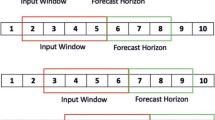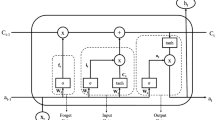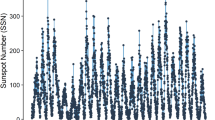Abstract
A deep-learning Vanilla, or single layer, Long Short-Term Memory model is proposed for improving the prediction of Solar Cycle 25. WDC-SILSO the Royal Observatory of Belgium, Brussels provides the 13-month smoothed sunspot-number data that were used to make this prediction. The root mean square error (RMSE) obtained by the proposed model, which is improved in comparison to the existing stacked LSTM model, lies within the range of 1.65 – 4.92, according to analysis on a number of temporal intervals taken into consideration in this study. The model performance has been validated by forecasting the peak amplitude of Solar Cycles 21 – 24. It is shown that for Cycles 21 and 22, the prediction error in estimating the peak is 1.159% and 0.423%, while the RMSE is estimated to be 4.149 and 3.274, respectively. For Cycle 23, the relative error and RMSE are 1.054% and 2.985, respectively, whereas for Cycle 24 they are 1.117% and 3.406, respectively. The current proposed model has exactly predicted the timing when the SSN reached its maximum for Cycle 23. While for Cycle 21, the prediction has a 1-month delay from the actual timing. For Cycles 22 and 24, the year during which the SSN reached maximum coincides with the observed year, although their month of peak occurrence showed a difference of three months and one month, respectively. The current proposed model suggests that the Cycle 25 will peak in April 2023 with an amplitude value of 136.9, which will be approximately 17.68% stronger compared with Cycle 24.












Similar content being viewed by others
Data Availability
The SSN version 2.0 has been taken from WDC-SILSO, Royal Observatory of Belgium, Brussels (www.sidc.be/silso/datafiles).
References
Ahluwalia, H.S., Ygbuhay, R.C.: 2009, Preliminary forecast for the peak of solar activity cycle 24. Adv. Space Res. 44, 611. DOI.
Ajabshirizadeh, A., Jouzdani, N.M., Abbassi, S.: 2011, Neural network prediction of solar cycle 24. Res. Astron. Astrophys. 11, 491. DOI.
Attia, A.F., Ismail, H.A., Basurah, H.M.: 2013, A neuro-fuzzy modeling for prediction of solar cycles 24 and 25. Astrophys. Space Sci. 344, 5. DOI.
Benson, B., Pan, W.D., Prasad, A., Gary, G.A., Hu, Q.: 2020, Forecasting solar cycle 25 using deep neural networks. Solar Phys. 295, 65. DOI.
Bhatt, N.J., Jain, R., Aggarwal, M.: 2009, Prediction of the maximum amplitude and timing of sunspot cycle 24. Solar Phys. 260, 225. DOI.
Bhowmik, P., Nandy, D.: 2018, Prediction of the strength and timing of sunspot cycle 25 reveal decadal-scale space environmental conditions. Nat. Commun. 9, 5209. DOI.
Bisoi, S.K., Janardhan, P., Ananthakrishnan, S.: 2020, Another mini solar maximum in the offing: a prediction for the amplitude of solar cycle 25. J. Geophys. Res. Space Phys. 125, e2019JA027508. DOI.
Bizzarri, I., Barghini, D., Mancuso, S., Alessio, S., Rubinetti, S., Taricco, C.: 2022, Forecasting the solar cycle 25 using a multistep Bayesian neural network. Mon. Not. Roy. Astron. Soc. 515, 5062. DOI.
Cao, J., Li, Z., Li, J.: 2019, Financial time series forecasting model based on CEEMDAN and LSTM. Physica A 519, 127. DOI.
Chang, Z., Zhang, Y., Chen, W.: 2018, Effective Adam-optimized LSTM neural network for electricity price forecasting. In: Wenzheng, L., Babu, M.S.P. (eds.) 9th Internat. Conf. Software Eng. Service Sci., ICSESS2018, IEEE. DOI.
Charbonneau, P.: 2010, Dynamo models of the solar cycle. Living Rev. Solar Phys. 7, 3. DOI.
Chen, Z., Gao, Y., Liu, Z.: 2005, Evaluation of solar radio bursts’ effect on GPS receiver signal tracking within International GPS Service network. Radio Sci. 40, 1. DOI.
Choudhuri, A.R.: 1992, Stochastic fluctuations of the solar dynamo. Astron. Astrophys. 253, 277.
Choudhuri, A.R., Chatterjee, P., Jiang, J.: 2007, Predicting solar cycle 24 with a solar dynamo model. Phys. Rev. Lett. 98, 131103. DOI.
Chowdhury, P., Jain, R., Ray, P.C., Burud, D., Chakrabarti, A.: 2021, Prediction of amplitude and timing of solar cycle 25. Solar Phys. 296, 69. DOI.
Coban, G.C., Raheem, A.U., Cavus, H., Asghari-Targhi, M.: 2021, Can solar cycle 25 be a new Dalton minimum? Solar Phys. 296, 156. DOI.
Courtillot, V., Lopes, F., Le Mouël, J.L.: 2021, On the prediction of solar cycles. Solar Phys. 296, 21. DOI.
Covas, E., Peixinho, N., Fernandes, J.: 2019, Neural network forecast of the sunspot butterfly diagram. Solar Phys. 294, 24. DOI.
Dabas, R.S., Sharma, K., Das, R.M., Pillai, K.G.M., Chopra, P., Sethi, N.K.: 2008, A prediction of solar cycle 24 using a modified precursor method. Solar Phys. 250, 171. DOI.
Dikpati, M., De Toma, G., Gilman, P.A.: 2006, Predicting the strength of solar cycle 24 using a flux-transport dynamo-based tool. Geophys. Res. Lett. 33, L05102. DOI.
Du, Z.L.: 2020a, The solar cycle: predicting the peak of solar cycle 25. Astrophys. Space Sci. 365, 104. DOI.
Du, Z.: 2020b, Predicting the shape of solar cycle 25 using a similar-cycle method. Solar Phys. 295, 134. DOI.
Echer, E., Rigozo, N., Nordemann, D., Vieira, L.: 2004, Prediction of solar activity on the basis of spectral characteristics of sunspot number. Ann. Geophys. 22, 2239. DOI.
Feynman, J., Gabriel, S.B.: 1990, Period and phase of the 88-year solar cycle and the Maunder minimum: evidence for a chaotic Sun. Solar Phys. 127, 393. DOI.
Gholipour, A., Lucas, C., Araabi, B.N., Shafiee, M.: 2005, Solar activity forecast: spectral analysis and neurofuzzy prediction. J. Atmos. Solar-Terr. Phys. 67, 595. DOI.
Gonçalves, Í.G., Echer, E., Frigo, E.: 2020, Sunspot cycle prediction using warped Gaussian process regression. Adv. Space Res. 65, 677. DOI.
Guo, W., Jiang, J., Wang, J.X.: 2021, A dynamo-based prediction of solar cycle 25. Solar Phys. 296, 136. DOI.
Han, Y.B., Yin, Z.Q.: 2019, A decline phase modeling for the prediction of solar cycle 25. Solar Phys. 294, 107. DOI.
Hathaway, D.H., Wilson, R.M.: 2006, Geomagnetic activity indicates large amplitude for sunspot cycle 24. Geophys. Res. Lett. 33, L18101. DOI.
Hawkes, G., Berger, M.A.: 2018, Magnetic helicity as a predictor of the solar cycle. Solar Phys. 293, 109. DOI.
Hiremath, K.M.: 2008, Prediction of solar cycle 24 and beyond. Astrophys. Space Sci. 314, 45. DOI.
Hochreiter, S., Schmidhuber, J.: 1997, Long short-term memory. Neural Comput. 9, 1735. DOI.
Jiang, J., Chatterjee, P., Choudhuri, A.R.: 2007, Solar activity forecast with a dynamo model. Mon. Not. Roy. Astron. Soc. 381, 1527. DOI.
Kakad, B.: 2011, A new method for prediction of peak sunspot number and ascent time of the solar cycle. Solar Phys. 270, 393. DOI.
Kane, R.P.: 1999, Prediction of the sunspot maximum of solar cycle 23 by extrapolation of spectral components. Solar Phys. 189, 217. DOI.
Kane, R.P.: 2007, A preliminary estimate of the size of the coming solar cycle 24, based on Ohl’s precursor method. Solar Phys. 243, 205. DOI.
Karak, B.B., Mandal, S., Banerjee, D.: 2018, Double peaks of the solar cycle: an explanation from a dynamo model. Astrophys. J. 866, 17. DOI.
Kim, M.Y., Wilson, J.W., Cucinotta, F.A.: 2006, A solar cycle statistical model for the projection of space radiation environment. Adv. Space Res. 37, 1741. DOI.
Kitiashvili, I.N.: 2016, Data assimilation approach for forecast of solar activity cycles. Astrophys. J. 831, 15. DOI.
Kitiashvili, I.N.: 2020, Application of synoptic magnetograms to global solar activity forecast. Astrophys. J. 890, 36. DOI.
Kitiashvili, I., Kosovichev, A.G.: 2008, Application of data assimilation method for predicting solar cycles. Astrophys. J. 688, L49. DOI.
Labonville, F., Charbonneau, P., Lemerle, A.: 2019, A dynamo-based forecast of solar cycle 25. Solar Phys. 294, 82. DOI.
Lantos, P.: 2006, The skewness of a solar cycle as a precursor of the amplitude of the next. Solar Phys. 236, 199. DOI.
Lantos, P., Richard, O.: 1998, On the prediction of maximum amplitude for solar cycles using geomagnetic precursors. Solar Phys. 182, 231. DOI.
Le, X.H., Ho, H.V., Lee, G., Jung, S.: 2019, Application of long short-term memory (LSTM) neural network for flood forecasting. Water 11, 1387. DOI.
Lee, T.: 2020, EMD and LSTM hybrid deep learning model for predicting sunspot number time series with a cyclic pattern. Solar Phys. 295, 82. DOI.
Li, Y., Cao, H.: 2018, Prediction for tourism flow based on LSTM neural network. Proc. Comput. Sci. 129, 277. DOI.
Li, F.Y., Kong, D.F., Xie, J.L., Xiang, N.B., Xu, J.C.: 2018, Solar cycle characteristics and their application in the prediction of cycle 25. J. Atmos. Solar-Terr. Phys. 181, 110. DOI.
Maris, G., Oncica, A.: 2006, Solar cycle 24 forecasts. Sun Geosph. 1, 8.
Miao, J., Wang, X., Ren, T.L., Li, Z.T.: 2020, Prediction verification of solar cycles 18 – 24 and a preliminary prediction of the maximum amplitude of solar cycle 25 based on the Precursor Method. Res. Astron. Astrophys. 20, 004. DOI.
Muñoz-Jaramillo, A., Balmaceda, L.A., DeLuca, E.E.: 2013, Using the dipolar and quadrupolar moments to improve solar-cycle predictions based on the polar magnetic fields. Phys. Rev. Lett. 111, 041106. DOI.
Nandy, D.: 2021, Progress in solar cycle predictions: sunspot cycles 24 – 25 in perspective. Solar Phys. 296, 54. DOI.
Nikou, M., Mansourfar, G., Bagherzadeh, J.: 2019, Stock price prediction using DEEP learning algorithm and its comparison with machine learning algorithms. Intell. Syst. Account. Finance Manag. 26, 164. DOI.
Okoh, D.I., Seemala, G.K., Rabiu, A.B., Uwamahoro, J., Habarulema, J.B., Aggarwal, M.: 2018, A hybrid regression-neural network (HR-NN) method for forecasting the solar activity. Space Weather 16, 1424. DOI.
Pala, Z., Atici, R.: 2019, Forecasting sunspot time series using deep learning methods. Solar Phys. 294, 50. DOI.
Passos, D.: 2011, Evolution of solar parameters since 1750 based on a truncated dynamo model. Astrophys. J. 744, 172. DOI.
Pesnell, W.D.: 2008, Predictions of solar cycle 24. Solar Phys. 252, 209. DOI.
Pesnell, W.D.: 2012, Solar cycle predictions (invited review). Solar Phys. 281, 507. DOI.
Pesnell, W.D.: 2016, Predictions of solar cycle 24: how are we doing? Space Weather 14, 10. DOI.
Pesnell, W.D.: 2020, Lessons learned from predictions of solar cycle 24. J. Space Weather Space Clim. 10, 60. DOI.
Pesnell, W.D., Schatten, K.H.: 2018, An early prediction of the amplitude of solar cycle 25. Solar Phys. 293, 1. DOI.
Petrovay, K.: 2010, Solar cycle prediction. Liv. Rev. Solar Phys. 7, 6. DOI.
Petrovay, K.: 2020, Solar cycle prediction. Liv. Rev. Solar Phys. 17, 2. DOI.
Petrovay, K., Nagy, M., Gerják, T., Juhász, L.: 2018, Precursors of an upcoming solar cycle at high latitudes from coronal green line data. J. Atmos. Solar-Terr. Phys. 176, 15. DOI.
Pishkalo, M.I.: 2010, Prediction of amplitude of solar cycle 24 based on polar magnetic field of the Sun at cycle minimum. Sun Geosph. 5, 47.
Podladchikova, T., Van der Linden, R.: 2011, An upper limit prediction of the peak sunspot number for solar cycle 24. J. Space Weather Space Clim. 1, A01. DOI.
Podladchikova, T., Van der Linden, R., Veronig, A.M.: 2017, Sunspot number second differences as a precursor of the following 11-year sunspot cycle. Astrophys. J. 850, 81. DOI.
Prasad, A., Roy, S., Sarkar, A., Panja, S.C., Patra, S.N.: 2022, Prediction of solar cycle 25 using deep learning based long short-term memory forecasting technique. Adv. Space Res. 69, 798. DOI.
Quassim, M.S., Attia, A.F., Elminir, H.K.: 2007, Forecasting the peak amplitude of the 24th and 25th sunspot cycles and accompanying geomagnetic activity. Solar Phys. 243, 253. DOI.
Sabarinath, A., Anilkumar, A.K.: 2018, Sunspot cycle prediction using multivariate regression and binary mixture of Laplace distribution model. J. Earth Syst. Sci. 127, 84. DOI.
Sarp, V., Kilcik, A., Yurchyshyn, V., Rozelot, J.P., Ozguc, A.: 2018, Prediction of solar cycle 25: a non-linear approach. Mon. Not. Roy. Astron. Soc. 481, 2981. DOI.
Schatten, K.: 2005, Fair space weather for solar cycle 24. Geophys. Res. Lett. 32, L21106. DOI.
Sello, S.: 2019, Solar cycle activity: an early prediction for cycle 25. arXiv.
Singh, A.K., Bhargawa, A.: 2017, An early prediction of 25th solar cycle using Hurst exponent. Astrophys. Space Sci. 362, 199. DOI.
Srivastava, N., Hinton, G., Krizhevsky, A., Sutskever, I., Salakhutdinov, R.: 2014, Dropout: a simple way to prevent neural networks from overfitting. J. Mach. Learn. Res. 15, 1929.
Svalgaard, L., Cliver, E.W., Kamide, Y.: 2005, Sunspot cycle 24: smallest cycle in 100 years? Geophys. Res. Lett. 32, L01104. DOI.
Thompson, R.J.: 1993, A technique for predicting the amplitude of the solar cycle. Solar Phys. 148, 383. DOI.
Upton, L.A., Hathaway, D.H.: 2018, An updated solar cycle 25 prediction with AFT: the modern minimum. Geophys. Res. Lett. 45, 8091. DOI.
Uwamahoro, J., McKinnell, L.A., Cilliers, P.J.: 2009, Forecasting solar cycle 24 using neural networks. J. Atmos. Solar-Terr. Phys. 71, 569. DOI.
Velankar, S., Valecha, S., Maji, S.: 2018, Bitcoin price prediction using machine learning. In: 20th Internat. Conf. Adv. Commun. Tech., ICACT 2018, IEEE. DOI.
Wang, Q.J., Li, J.C., Guo, L.Q.: 2021, Solar cycle prediction using a long short-term memory deep learning model. Res. Astron. Astrophys. 21, 012. DOI.
Wang, Y.M., Sheeley, N.R.: 2009, Understanding the geomagnetic precursor of the solar cycle. Astrophys. J. Lett. 694, L11. DOI.
Wang, J.L., Zong, W.G., Le, G.M., Zhao, H.J., Tang, Y.Q., Zhang, Y.: 2009, Predicting the start and maximum amplitude of solar cycle 24 using similar phases and a cycle grouping. Res. Astron. Astrophys. 9, 133. DOI.
Wilson, R.M., Hathaway, D.H., Reichmann, E.J.: 1998, An estimate for the size of cycle 23 based on near minimum conditions. J. Geophys. Res. Space Phys. 103, 6595. DOI.
Xiong, Y., Lu, J., Zhao, K., Sun, M., Gao, Y.: 2021, Forecasting solar cycle 25 using comprehensive precursor combination and multiple regression technique. Mon. Not. Roy. Astron. Soc. 505, 1046. DOI.
Xu, T., Wu, J., Wu, Z.S., Li, Q.: 2008, Long-term sunspot number prediction based on EMD analysis and AR model. Chin. J. Astron. Astrophys. 8, 337. DOI.
Yan, Y., Stenning, D.C., Kashyap, V.L., Yu, Y.: 2021, Forecasting solar cycle 25 with a principled Bayesian two-stage statistical model. Res. Notes AAS 5, 192. DOI.
Zięba, S., Nieckarz, Z.: 2012, Sunspot time series – relations inferred from the location of the longest spotless segments. Solar Phys. 278, 457. DOI.
Acknowledgments
We thank to the WDC-SILSO, Royal Observatory of Belgium, Brussels for the sunspot-number data. We sincerely acknowledge the support extended by Jadavpur University, West Bengal India.
Author information
Authors and Affiliations
Contributions
Amrita Prasad did the conceptualization of the article, performed the experimental analysis of the article, and wrote the original draft. Soumya Roy contributed in editing the manuscript, writing-review and software. Arindam Sarkar did the conceptualization of the article, supervised the work and helped in formal analysis. Subhash. C. Panja helped in editing of the manuscript as well as writing-review. Sankar Narayan Patra provided the resources for carrying out the experimental work, helped in the writing and editing of the article.
Corresponding author
Ethics declarations
Competing Interests
The authors declare no competing interests.
Additional information
Publisher’s Note
Springer Nature remains neutral with regard to jurisdictional claims in published maps and institutional affiliations.
Rights and permissions
Springer Nature or its licensor (e.g. a society or other partner) holds exclusive rights to this article under a publishing agreement with the author(s) or other rightsholder(s); author self-archiving of the accepted manuscript version of this article is solely governed by the terms of such publishing agreement and applicable law.
About this article
Cite this article
Prasad, A., Roy, S., Sarkar, A. et al. An Improved Prediction of Solar Cycle 25 Using Deep Learning Based Neural Network. Sol Phys 298, 50 (2023). https://doi.org/10.1007/s11207-023-02129-2
Received:
Accepted:
Published:
DOI: https://doi.org/10.1007/s11207-023-02129-2




